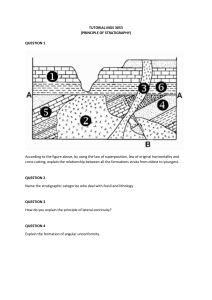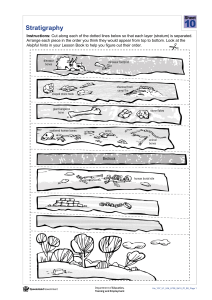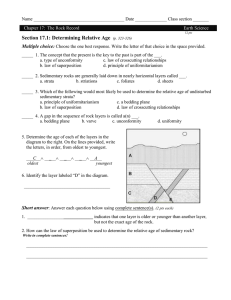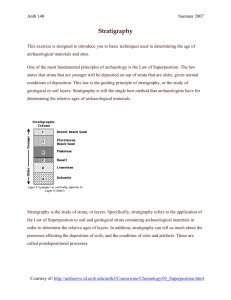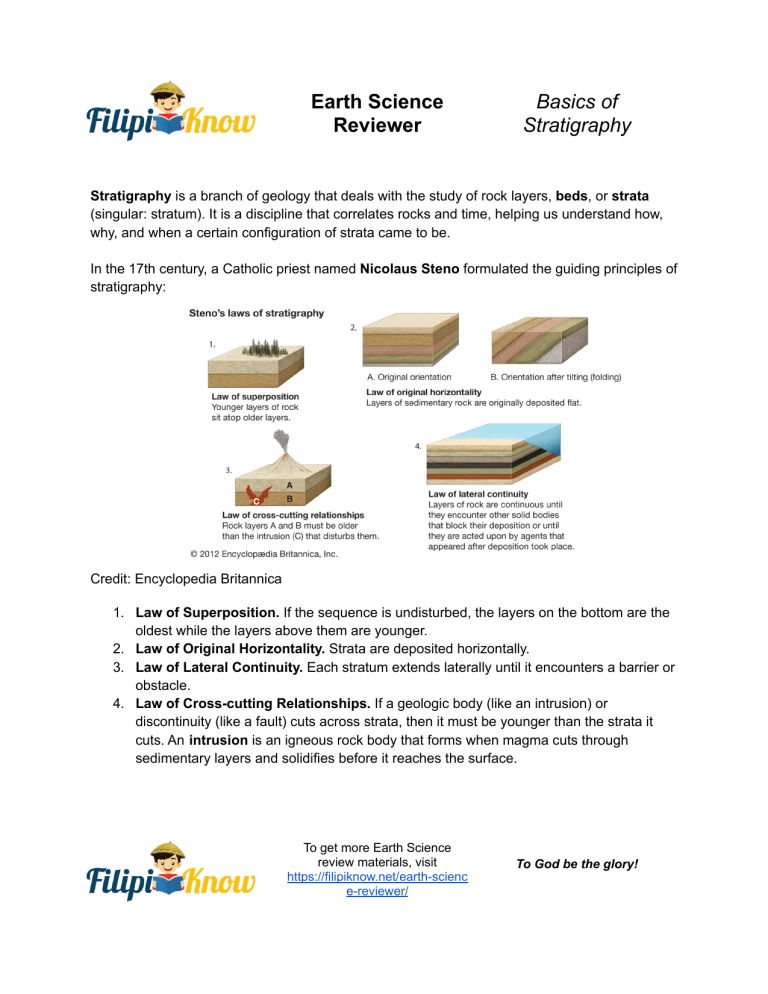
Earth Science Reviewer Basics of Stratigraphy Stratigraphy is a branch of geology that deals with the study of rock layers, beds, or strata (singular: stratum). It is a discipline that correlates rocks and time, helping us understand how, why, and when a certain configuration of strata came to be. In the 17th century, a Catholic priest named Nicolaus Steno formulated the guiding principles of stratigraphy: Credit: Encyclopedia Britannica 1. Law of Superposition. If the sequence is undisturbed, the layers on the bottom are the oldest while the layers above them are younger. 2. Law of Original Horizontality. Strata are deposited horizontally. 3. Law of Lateral Continuity. Each stratum extends laterally until it encounters a barrier or obstacle. 4. Law of Cross-cutting Relationships. If a geologic body (like an intrusion) or discontinuity (like a fault) cuts across strata, then it must be younger than the strata it cuts. An intrusion is an igneous rock body that forms when magma cuts through sedimentary layers and solidifies before it reaches the surface. To get more Earth Science review materials, visit https://filipiknow.net/earth-scienc e-reviewer/ To God be the glory! Earth Science Reviewer Basics of Stratigraphy In the 19th century, an English geologist named William Smith applied these principles and produced the first geological map of Britain. Since then, he was regarded as the Father of English Geology. He also introduced another important principle of stratigraphy: 5. Principle of Faunal Succession. Sedimentary strata may contain fossils of plants and animals in a definite and invariable sequence. Thus, the age of a stratum and another stratum in a different location can be correlated if they share the same fossil assemblage. Sometimes, different processes can occur that can lead to a gap in a rock sequence called an unconformity. The “missing time” represented by the unconformity in a rock sequence is called a hiatus. There are three types of unconformities: To get more Earth Science review materials, visit https://filipiknow.net/earth-scienc e-reviewer/ To God be the glory! Earth Science Reviewer Basics of Stratigraphy 1. Disconformity. This type of unconformity is present when there is a missing stratum or strata in the sequence, usually due to a period of non-deposition or erosion. 2. Nonconformity. This occurs when sedimentary strata are deposited on top of igneous or metamorphic rock bodies. 3. Angular unconformity. When strata are disturbed by forces that cause folding, tilting, and/or faulting, they no longer appear horizontal. The surface is then exposed to erosion and soon, another set of sedimentary strata is deposited on top of the disturbed sequence. These principles and unconformities can be used to identify the age of strata in relation to other strata in a method called relative dating. However, this method cannot identify the specific or absolute age of a stratum. Determining the absolute age of a layer requires certain techniques collectively known as absolute dating. One of the best ways to date the numerical age of a rock is to use an absolute dating method called radioisotopic dating or radiometric dating. As you’ve learned in chemistry, isotopes are atoms of an element that have different numbers of neutrons and thus, different atomic masses. Radioactive isotopes are unstable (parent isotope) and lose subatomic particles or energy over time in a process called radioactive decay. Eventually, the parent isotope’s configuration reaches a more stable configuration and turns into a daughter isotope. The half-life of a radioactive isotope refers to the time it takes for half of the atoms in a substance to decay. Depending on the rock type, different radiometric dating methods can be used. Here are some of the most common radiometric dating methods: To get more Earth Science review materials, visit https://filipiknow.net/earth-scienc e-reviewer/ To God be the glory! Earth Science Reviewer Basics of Stratigraphy One important thing to note in the table above is that even though 14C – 14N Dating is a common dating technique, it does not date the age of the sediments of the rocks. Rather, it is commonly used to date fossils (which contain C) in a rock. Fossils are essential to stratigraphy and serve as a doorway through which we can know more about prehistoric life. We shall discuss more about fossils in the next portion. To get more Earth Science review materials, visit https://filipiknow.net/earth-scienc e-reviewer/ To God be the glory!
